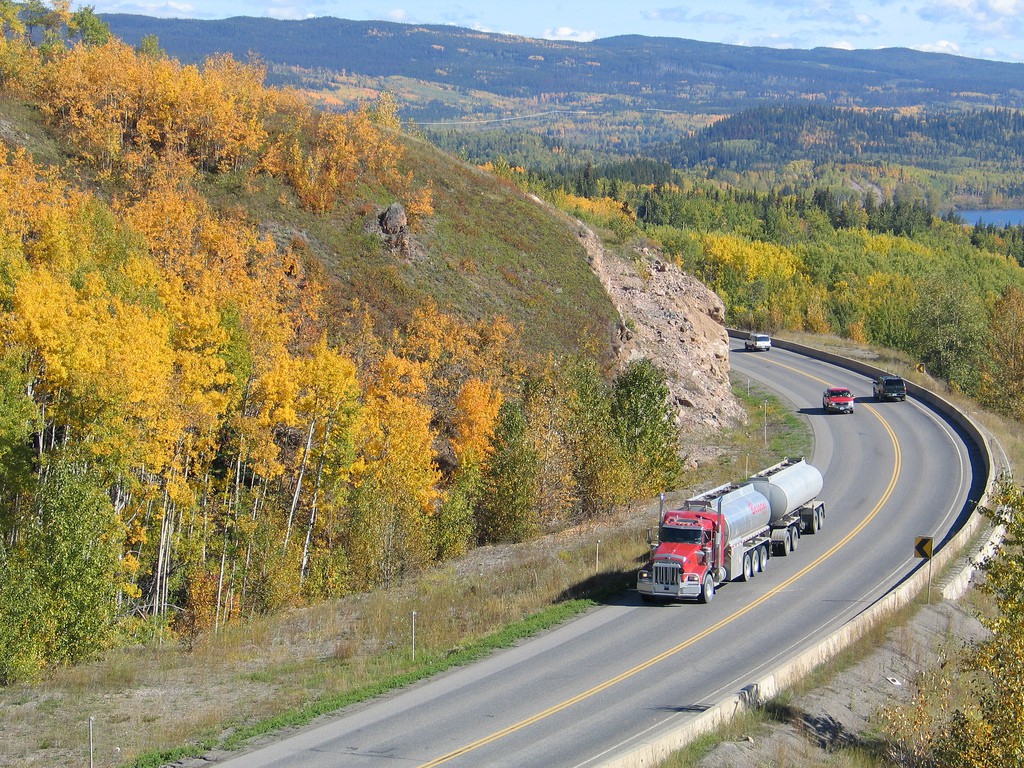
Transport trucks play a big role in getting goods to markets across British Columbia.
They’re also physically huge, heavy and behave much differently than you…
While motorists travel on the same road as commercial transport vehicles, not all drivers are fully aware of who they are sharing the road with. Knowing the characteristics of large commercial vehicles, and how they operate, will help you stay safe on the road.
The enormous size and weight of commercial vehicles mean they maneuver much differently than your passenger vehicle. And, what the truck driver sees from a transport truck cab is more limited than what you view from your cockpit. Given these contrasts, here are 10 ways for you to safely share the road with commercial vehicles.
1. Stay out of the truck’s blind spots
Trucks have blind spots on all sides – front, rear and alongside. The driver can’t see you at all if you’re in front, close to their bumper, and especially if you’re near the right front bumper. They also can’t see you if you’re travelling closely behind, or in some spots beside the truck. If you keep your distance and allow lots of space between you and the truck, you can mostly avoid these blind spots. When passing (done on the left) keep moving.
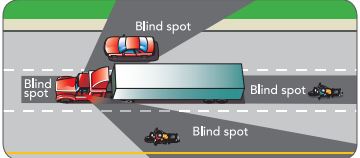
Mirrors will help you know if you’re clear of the blind spots. If you can see the truck’s side mirror when you’re behind the truck, the driver can see you. (Staying further back also provides a wider view of the road ahead.) When in front of a truck, be sure you can see the truck’s windshield, in your rear view mirror. It’s best to travel on the left side of the truck (though, if possible, don’t linger there).
2. Don’t cut in front
Transport trucks have a lot of weight behind them. It takes a lot longer for a 40,000-kilogram load to stop than it does for any private passenger vehicle. So, don’t cut in front of a truck, because the driver may not see you (due to the blind spots mentioned above) and if you need to suddenly stop, even if they know you’re there, they can’t stop as quickly as you. It’s especially important to never, ever zip in front of a truck just before a traffic signal. The light could turn red, and you may reduce the space that the driver has allowed themselves for stopping.
3. Allow loads of room for passing
Check out how long the load is before you decide to pass – some trucks pull two trailers. Be sure you’ve got lots of room and time to travel the length of the load and don’t pull back into the lane, until you can see the truck’s windshield in your rear view mirror.
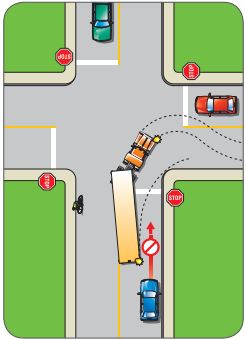
4. Give oversize loads extra respect (and space)
A truck or pilot car with a sign that says “Wide Load,” “Long Load” or “Oversize Load” means they may travel slowly, and extra caution and patience are needed. (And you might get to see something really cool being moved – like a gigantic windmill blade or a house!) Check out these tips and never follow a pilot car when it’s passing the load.
5. Stay out of the squeeze
Being long, trucks and their loads need more room to pivot. When turning right, the truck may swing wide into the lane beside, and motorists might mistakenly think that the right lane has become available. But the gap is only temporary, and as the trailer travels around the corner, it returns to the right lane. If motorists decide to come up alongside the truck in that right lane, they can get “squeezed” between the trailer and the curb. (Not a nice, friendly squeeze!)A similar situation (without “the squeeze”) can happen when a truck is turning left, and there are two lanes going in the same direction. Do not come alongside the left side of the truck, as it travels to the right. The truck will be re-occupying the left lane.
“Squeeze” a hazard for cyclists and pedestrians too
Cyclists, be cautious when riding or stopping beside a truck that is turning right – the driver may not know you’re there. Move a few feet from the road, or go up on the curb to allow some breathing room. Pedestrians standing at the corner of an intersection are vulnerable if the trailer creeps onto the shoulder. Stand back from the roadway and keep your eyes on the traffic.
6. Tune into turbulence
Yes, you already have your seatbelt fastened, but did you consider how large transport trucks in motion create wind currents and changes in air pressure? Turbulence can make it more difficult to control your vehicle, especially on slippery roads. Motorists hauling trailers or campers, and motorcyclists, are especially affected. Whenever trucks are coming or going near you, keep a firm hold of your steering wheel.
7. Watch for heavy weather
In nasty weather, big trucks may throw extra snow, mud, rain and slush onto your windshield and obscure the view ahead.
8. Beware the roll
When a truck that is facing uphill releases its brakes, the truck may roll backwards a bit before moving ahead. Allow some extra space for this when you are behind a stopped truck.
9. Provide lots of advanced notice and room
Given the restricted view of the truck driver, and the greater stopping distance needed by trucks, let them know what you’re up to. Signal early and follow four seconds behind.
10. Keep out of runaway lanes
When heavy trucks going down certain BC mountain roads find themselves out of control, they can take runaway lanes to prevent a crash (and possibly save their lives and the lives of others). So, NEVER stop in a runaway lane – they are emergency exits for the sole use of commercial truck drivers. There are a surprising number of motorists who block runaway lanes, to take a break, pull out a picnic or even go tobogganing.
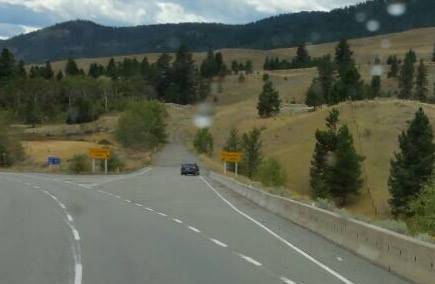
A COURTESY TO COMMERCIAL CARRIERSConsider the needs of truckers, who work long, unpredictable hours in often trying conditions…Please do not park in spaces designed for commercial vehicles. Drivers of big rigs need room to park, conduct brake checks, take their required rest breaks, stop at vehicle inspection stations, and then pull forward smoothly to hit the road again. If you need to park at a pullout, please park to the far right near the exit, so that you’re not blocking the way for large trucks to come and go. We ask that you not use the facilities at vehicle inspection stations, but instead stop at our highway rest areas.
|
Despite their different-sized vehicles, truck drivers and non-commercial drivers have a shared interest in getting to their destinations safely. By following the tips above, you can help keep everyone’s driver stress levels in check, and help truckers deliver their goods and keep our economy moving.
Thank you to Kristin McCallum for contributing the photos of passenger vehicles parked where they should not be. Thanks also to Kym Dèscentè and Kristin for supplying the link to the “tobogganing” photo, and to Jackie Hendrix for sharing her top concerns. Illustrations are courtesy of ICBC.
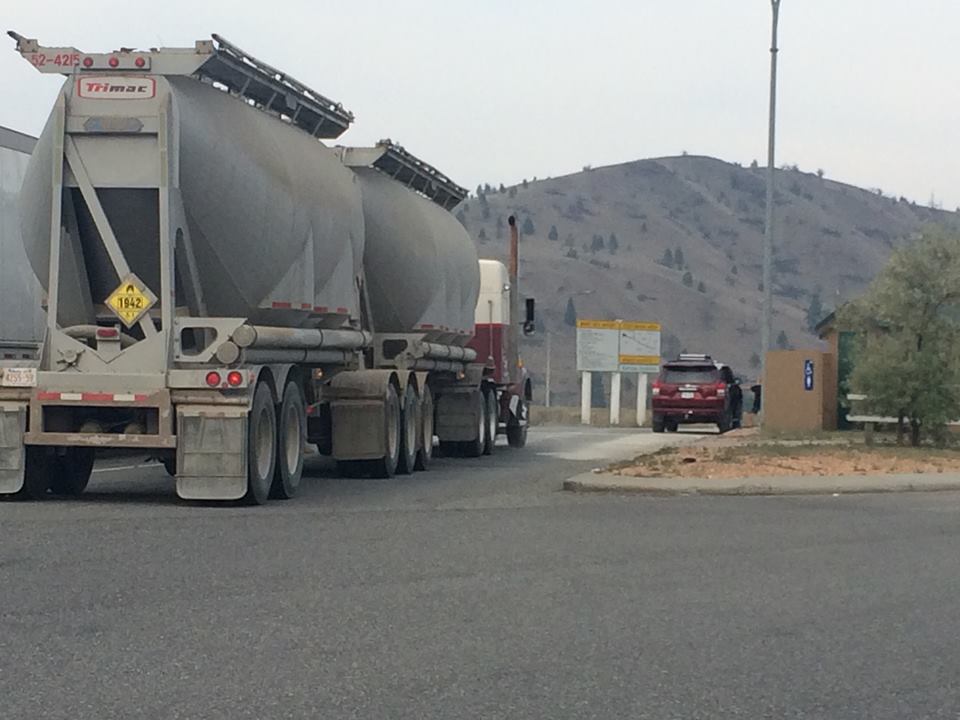 Photo courtesy of Kristin McCallum
Photo courtesy of Kristin McCallum
Join the discussion